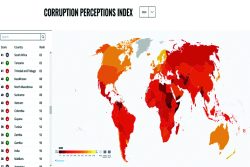Forecasting Guyana to be the fourth top global oil producer by 2035, Rystad Energy has said that all of its reports and projections for this country are independently conducted and are based on facts and numbers before it, despite the fact that many of its clients are oil companies.
“Yes, ExxonMobil is a client. Shell is a client. Total is a client. Hess is a client… we have all those clients that have subscription fees from us,” Senior Vice President and Head of Latin America and the Caribbean for Rystad Energy Schreiner Parker said on Thursday as he made a presentation on a white paper, “Guyana Upstream,” recently compiled by his company.
But Parker was quick to add that that no reports are skewed in favour of any of its clients. “They are completely independent.”
The event, held at Roraima Duke Lodge, was organized by Rystad Energy, the GCCI, and Oil Now.
Faced with questions about the integrity of its analyses on Guyana’s oil sector, the Norway-headquartered consulting firm admitted to its clients being oil companies but pointed to its many reports on other issues such as the impact of COVID-19 on the sector, renewable energy, and economic analyses.
“There is a delineation between our clients and what we put out into the public sphere for consumption. If you look at the COVID-19 reports… we do press releases, commentaries, in order to maintain Rystad Energy as a top provider of intelligence and information in the energy space. We act independently to be able to put this out there,” he assured.
According to Rystad, the facts are that when you analyze Guyana’s oil sector, even with just a focus on the current 33 discoveries and the 11 billion recoverable barrels in the Stabroek Block, the projection is that only Saudi Arabia, Brazil, and the United Arab Emirates will produce more oil on an annual basis.
“Prolific exploration and a steady pace of Final Investment Decisions [FID] will propel Guyana to be the world’s fourth offshore oil producer by 2025, with an estimated 1.7 billion of oil production,” Parker said as he juxtaposed two graphs comparing where this country was ranked in 2015 to projections for 2035.
In 2018 when ExxonMobil was at its eighth discovery and when Parker first came to Guyana, he had told this newspaper that this country could reap about US$20 billion in profits from just those discoveries alone.
Rystad’s projections seemed to be correct, as years later those figures were also floated by other analysts and the companies.
But in addition to being a top producer by the next decade, Parker said that this country’s light sweet crude will be in demand for decades to come, despite the global move towards renewables.
“This is really significant in the sense that when you have this low emissions intensity and the low cost resource, you’re able to be a long-term supplier for oil and gas no matter what the energy transition does and I think that demand figure of between 50 and 30 million barrels per day means that Guyana will have a place at that supply table because of these necessary and sufficient conditions,” Parker explained.
“In addition to the need for production from new sources, including discoveries, he said the crude has to be low cost in order to be profitable and emit low amounts of carbon in an era of energy transition to cleaner energy and renewables. “That’s what the global community is concerned about these days. Guyana has both the necessary and sufficient conditions to be a producer and be a part of the supply mix in the long term in 2040s and 2050s,” he added.
Parker’s presentation replicated much of what the company had said in a press release late last month that government revenue from domestic production is on track to break the US$1 billion mark this year and accelerate to US$7.5 billion annually in 2030.
Rystad believes that this year is set to be a turning point for government to start capitalising on the vast reserves in the offshore field, with revenues more than doubling over 2021 levels.
“Low breakevens and below-average emissions intensity in the Stabroek will propel Guyana from a relatively small producer to a global leader in the coming years, solidifying the country’s position as a competitive and policy-friendly player for offshore production. The government’s take from the production is expected to increase until 2025, reaching US$4.2 billion annually,” the report said.
“Triggered by a forecasted drop in oil prices and continued spending on the field’s development, government revenues will fall to US$2.4 billion in 2027. Still, production growth is set to accelerate, with revenue momentum resuming as new pre-Final Investment Decision projects are sanctioned and brought online, leading to peak government revenues of $16 billion in 2036. These projections do not factor in as-yet undiscovered resources,” it added.
Comparing the fiscal regimes of other offshore leaders, Rystad said that Guyana’s is on the higher end, with the government take clocking in at 59% of total value. In contrast, applying the US fiscal regime to the Stabroek Block would result in a government take of only 40%. Nigeria and Brazil align more with Guyana’s fiscal policies, with 58% and 61%, respectively.
Parker and attorney and accountant Christopher Ram shared different figures with Ram saying that accounts and numbers could not give 59% when the Production Sharing Agreement states 50% and royalty 2%.
Rystad, however, contends that the cost of supply is a significant factor in considering the desirability of assets and comparing them to other sources and regions.
“Helping to transform Guyana into a global heavyweight in offshore production is its competitive breakeven costs, which average $28 per barrel across all projects and less than $20 for producing projects. Guyana’s offshore oil fields are some of the most competitive supply sources outside of the Middle East and offshore Norway and are cheaper than the US onshore heavyweight, the Permian, Russia and many other sources,” the company states.
Parker also spoke on emissions intensity from offshore activity here and said that Guyana’s is lower than the global average for oil and gas production and deep-water offshore production, which Rystad believes is “further strengthening the country’s position through the energy transition.”
Upstream emissions from Guyana’s deep-water activities average 9 kilograms of CO2 per BOE (barrels of oil equivalent), comparable to Brazil and slightly higher than Norway and is likely to remain low, according to the Rystad report. It says that this is due to a number of factors, including that more state-of-the-art FPSOs will be used at future developments.
That Guyana has instituted a Natural Resource Fund, joined EITI in 2017, and enacted local content laws was positively highlighted under the report’s governance mechanisms and institutions that have been implemented.
But it noted that with all done, “Still it may not be all plain sailing.”
“Strong institutional governance, transparency and regulatory practices will be vital to unlocking the full potential of Guyana’s resource wealth for its society. Although the government has taken steps to improve governance, including establishing a sovereign wealth fund and improving fiscal policy transparency, there are still improvements to be made,” it said.
As an example, mention was made of the report by the Extractives Industries Transparency Initiative (EITI), which champions strong resource management and governance practices, which found several weaknesses in Guyana’s company reporting and tax processes.
However, Rystad believes that Guyana’s EITI score “will likely grow in the coming years as recent improvements take effect.”







